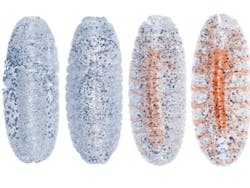Autonomous microscope allows adaptive live imaging of large living organisms
Recognizing that achieving high-resolution images with light-sheet microscopes requires manual adjustments during imaging, a team of researchers at the Max Planck Institute of Molecular Cell Biology and Genetics (Dresden, Germany) and colleagues at the Howard Hughes Medical Institute (HHMI) Janelia Research Campus (Ashburn, VA) has developed a light-sheet microscope that can drive itself automatically by adapting to the challenging and dynamic optical conditions of large living specimens.
Related: Light microscope can image whole living organisms at high resolution
The research team's smart microscope combines a novel hardware design and a smart AutoPilot system that can analyze images and automatically adjust and optimize the microscope. This framework enables long-term adaptive imaging of entire developing embryos, and improves the resolution of light-sheet microscopes up to five-fold.
In a light-sheet microscope, a laser light sheet illuminates the sample perpendicularly to the observation along a thin plane within the sample. Out-of-focus and scattered light from other planes—which often impair image quality—is largely avoided because only the observed plane is illuminated.
The long-standing goal of microscopy is to achieve ever-sharper images deep inside of living samples. For light-sheet microscopes, this requires to perfectly maintain the careful alignments between imaging and light-sheet illumination planes. Mismatches between these planes arise from the optical variability of living tissues across different locations and over time. Tackling this challenge is essential to acquire the high-resolution images necessary to decipher the biology behind organism development and morphogenesis.
"So far, researchers had to sit at their microscope and tweak things manually—our system puts an end to this. It is like a self-driving car—it functions autonomously," says Loïc Royer, first author of the study. This smart autonomous microscope can in real time analyze and optimize the spatial relationship between light sheets and detection planes across the specimen volume.
The researchers demonstrated the performance of their smart microscope by imaging the development of zebrafish and fly embryos for more than 20 hours. They also performed adaptive whole-brain functional imaging in larval zebrafish, obtaining sharper images of a whole "thinking" fish brain.
In the study, they show how their system recovers cellular and subcellular resolution in many regions of the sample and how it adapts to changes in the spatial distribution of fluorescent markers. "We have been using our AutoPilot system on several microscopes for more than two years, and it makes a big difference in terms of image quality," says Philipp Keller, one of the senior authors of the study (along with Gene Myers).
Making microscopes adaptive and autonomous is important, as it will enable future use of light-sheet microscopy for automated high-throughput drug screening, mutant screening, and the construction of anatomical and developmental atlases in various biological model systems.
Full details of the work appear in the journal Nature Biotechnology; for more information, please visit http://dx.doi.org/10.1038/nbt.3708.

